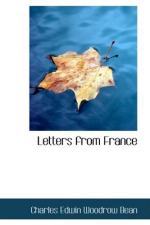THE NEW ENTRY
France, November 13th.
Last week an Australian force made its attack in quite a different area of the Somme battle.
The sky was blue in patches, with cold white clouds between. The wind drove icily. There had been practically no rain for two days.
We were in a new corner. The New Zealanders had pushed right through to the comparatively green country just here—and so had the British to north and south of it. We were well over the slope of the main ridge, up which the Somme battle raged for the first three months. Pozieres, the highest point, where Australians first peeped over it, lay miles away to our left rear. From the top of the ridge behind you, looking back over your left shoulder, you could just see a few distant broken tree stumps. I think they marked the site of that old nightmare.
We were looking down a long even slope to a long up-slope beyond. The country around us was mostly brown-mud shell-holes. Not like the shell-holes of that blasted hill-top of two months back—I have never seen anything quite like that, though they say that Guillemont, which I have not seen, is as devastated. In this present area there is green grass between the rims of the craters. But not enough green grass to matter. The general colour of the country on the British side is brown—all gradations of it—from thin, sloppy, grey-brown mud, trampled liquid with the feet of men and horses, to dull, putty-like brown mud so thick that, when you get your foot into it, you have a constant problem of getting it out again.
For it is the country over which the fight has passed. As we advance, we advance always on to the area which has been torn with shells—where the villages and the trenches and the surface of the green country have been battered and shattered, first by our guns and then by the German guns, until they have made a hell out of heaven.
And always just ahead of us, a mile or so behind the German lines, there is heaven smiling—you can see it clearly; in this part, up the opposite slope of the wide, open valley. There is the green country on which the Germans are always being driven back, and up which this monstrous engine of war has not yet begun its slow, gruesome climb. There are the beautiful green woods fading to soft autumn brown and yellow—the little red roofs in the trees, an empty village in the foreground—you can see the wet mud shining in its street and the white trickle of water down the centre of the road.
Down our long muddy hill-slope, near where the knuckles of it dip out of sight into the bottom of the valley, one notices a line of heads. In some places they are clear and in others they cannot be seen. But we guess that it is the line ready to go out.
At the top of the opposite up-slope the tower of Bapaume town hall showed up behind the trees. We made out that the hands of the clock were at the hour—but I have heard others say that they were permanently at half-past five, and others a quarter past four—it is one of those matters which become very important on these long dark evenings, and friendships are apt to be broken over it. The clock tower, unfortunately, disappeared finally at eighteen minutes past eleven yesterday morning, so the controversy is never likely to be settled.




